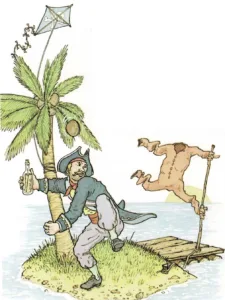Energy from movement
Poor old Bristlebones! His pirate ship has sailed away and he’s stranded
on a tiny island. He can think of only three ways to get help. He can
fly a kite and hope somebody on another ship sees it. He can put a
message in a bottle and let it float away in the ocean for someone to
find. Or he can build a raft with a sail and try to get away.
Each of Bristlebones’ ideas depends on a kind of energy to work—the
movement of wind to lift a kite or push a sail, or the movement of water
to carry a bottle. Moving things like wind and water have energy that
can be used to give something else a push or a pull. This kind of energy
is called kinetic (kih [neht]{.smallcaps} ihk) energy. Kinetic comes
from a Greek word for \”move.” Kinetic energy is the energy of moving
things.
Anything that is moving has kinetic energy—even the coconuts that
fall from the trees on Bristlebones’ island. While the coconuts are
falling, they have kinetic energy. They can give quite a push to
anything they hit, including Bristlebones’ head!
But even before the coconuts fall, they have another kind of energy.
They aren’t moving, so it isn’t kinetic energy. But they could
move—they could fall. The coconuts in the tree have what is called
potential energy. Potential means \”possible.” Potential energy

is often called \”stored energy\”—energy that could be used.
The coconuts on the tree have potential energy. On the ground, they have
no energy at all—they aren’t moving, and they can’t move. But if
Bristlebones picks one up, it has potential energy again—it could be
made to move by dropping it, rolling it, or throwing it.

